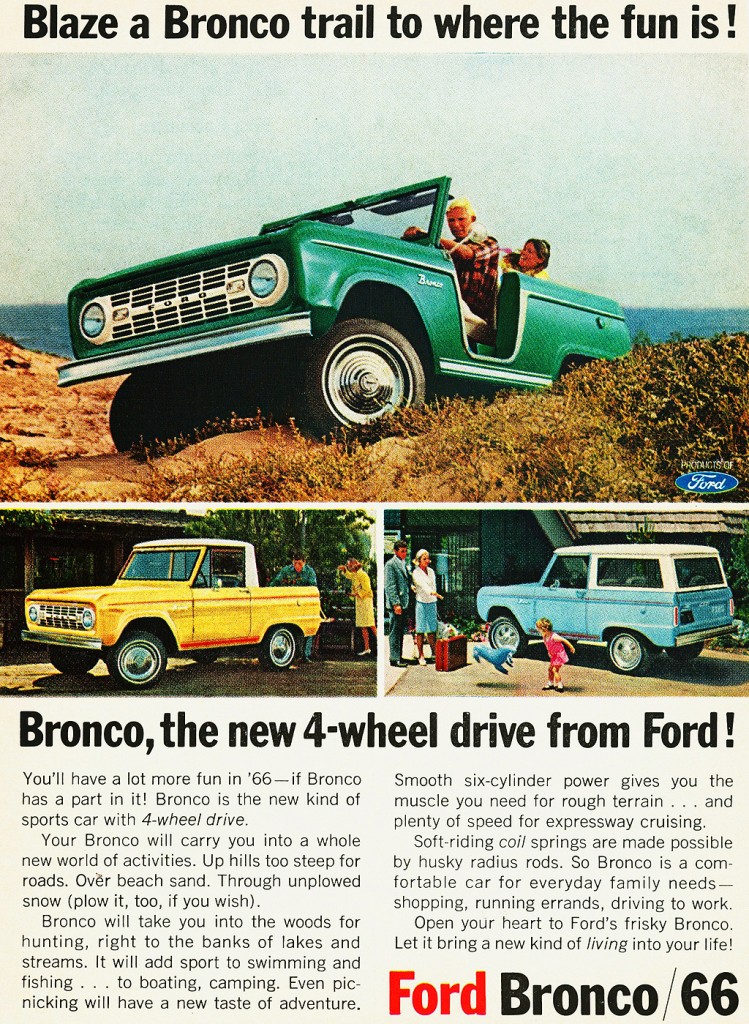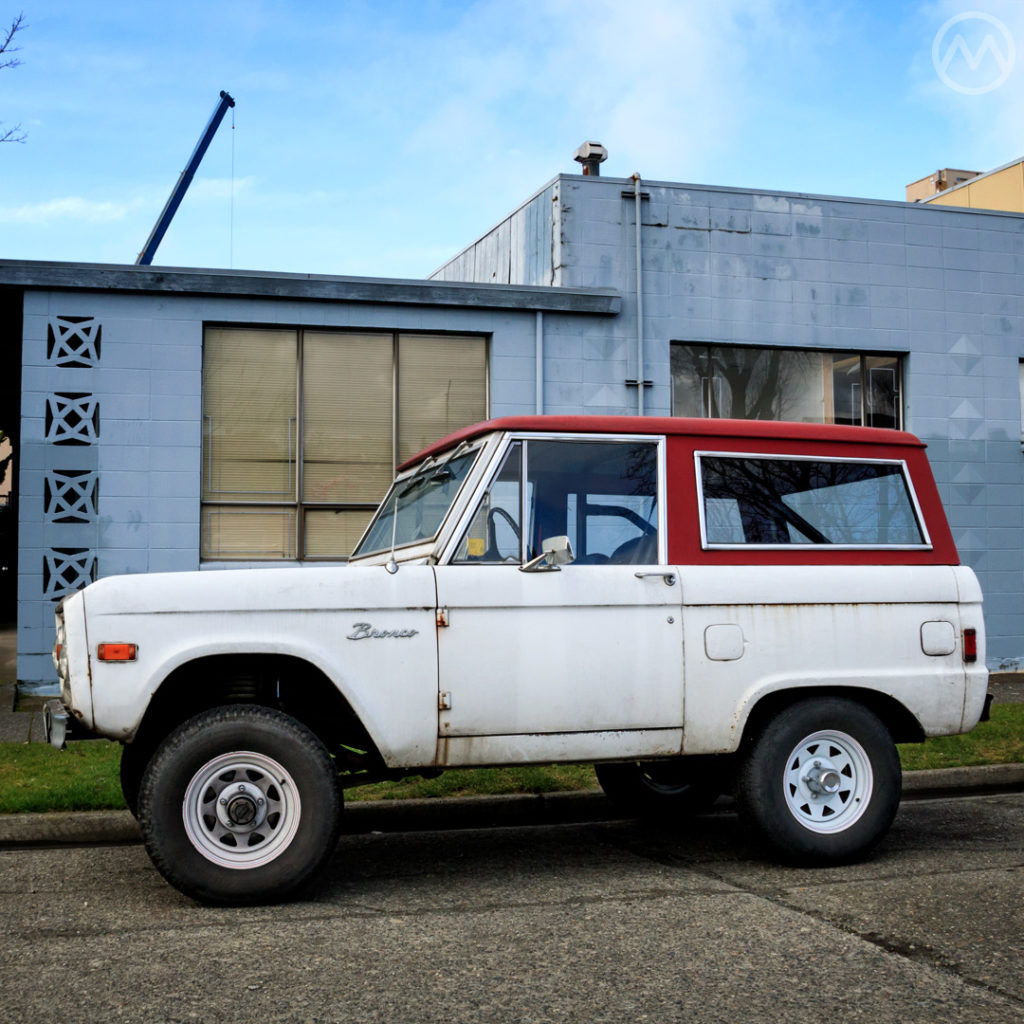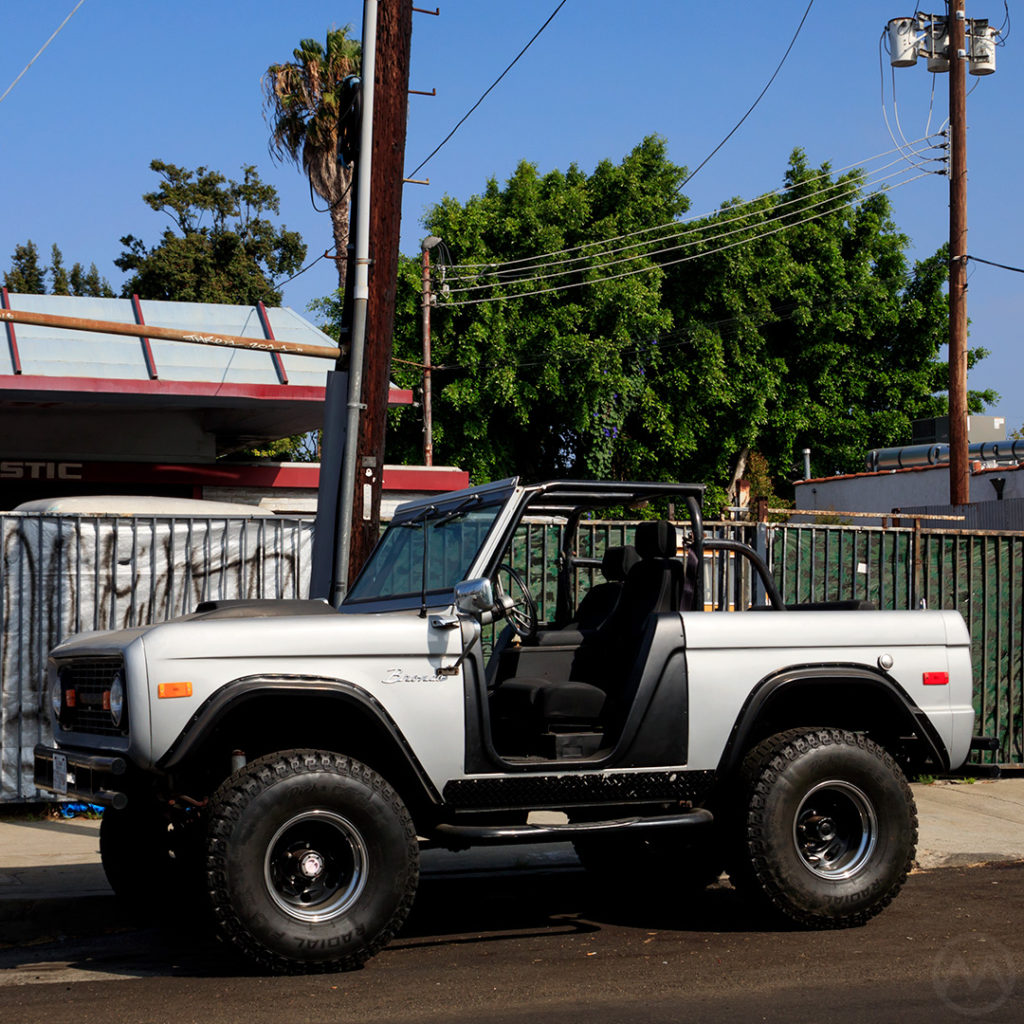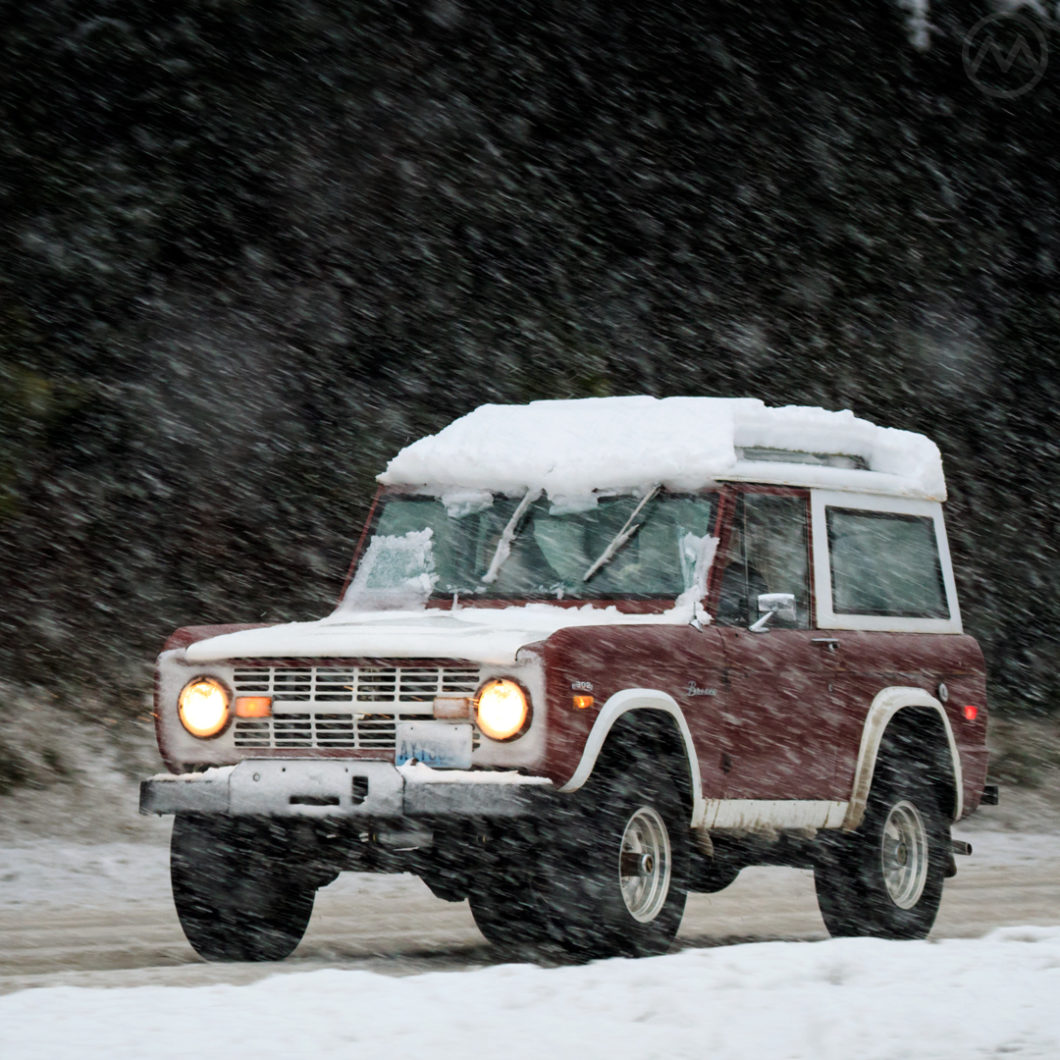It could be fairly said that 1964 was Ford’s year of the horse. That April, Ford’s epoch-defining Mustang debuted at the New York World’s fair. The Mustang not only created an entirely new market, it had a ripple effect on small sporty cars for decades. But for more than a year by then, Ford had been working on a horse of a different color – the Bronco. Debuting the following year, the Bronco became Ford’s first SUV, and served the blue oval dutifully for over a decade.
Unlike the Mustang, the Bronco was not the vehicle that defined its niche. Its origin lies with both the Willys and Kaiser Jeeps of the forties and fifties and, more immediately, the International Harvester Scout of 1961.
International Harvester Corporation (IHC), with its agricultural and truck expertise, had seen the evolution of off-road enthusiasts (born of surplus Army jeeps, then catered to pretty much exclusively by Willys/Kaiser Jeep) grow into a sizable niche market and correctly assumed that there was a market for a vehicle which blended the off-road prowess of the Jeep with the on-road practicality and comfort of their own trucks.
Nor was IHC alone in that conclusion. Willy’s original Jeepster had veered into car territory and the Willys Wagon was progressively made a little quieter and plusher. In the U.K., Rover had briefly produced a more civilized Land Rover, the “80 inch station wagon” in 1950/51 and returned to the idea with a series of “Road Rover” prototypes later in that decade, but they never materialized until the 1971 Range Rover.
Around the time of the last “Road Rover,” IHC’s chief designer, Ted Ornas, worked up a concept for a roadgoing, plastic-bodied off-roader that was small and capable like a Jeep CJ, but full-bodied and comfortable like a car. It came with a smaller engine than IHC’s pickups and could be ordered in RWD or 4WD, as a pickup or an enclosed wagon.
IHC liked the idea but not the plastic – it was reworked in steel and the International Harvester Scout, arguably the first modern SUV, was born. The first one rolled off the line on Nov. 30, 1960. The Scout was an immediate success, and 80% of sales were 4WD closed models. Jeep had nothing directly comparable.
In 1960, only about 11-12,000 vehicles that would be comparable to “SUVs” today were sold in all of the United States. In 1962 it was 32,000, with 85% of them Jeeps or IHCs, and the other 15% two entries from Japan – the Toyota Land Cruiser and the Nissan Patrol. GM and Ford soon took notice.
The Horse Whisperer
Executive Don Frey (recently portrayed by Joe Williamson in Ford Vs. Ferrari) joined Ford in 1951 as a research analyst and seven years later found himself chief engineer for Ford passenger cars. That was right before the Edsel crisis and the subsequent breakup of Ford’s “Whiz kids” team.
In 1960, he started to get closer to Lee Iacocca, who’s informal “Fairlane Group” rapidly became the successor to the Whiz kids and by 1961-62 the de facto source tasked with drumming up new product ideas. It was here that the Mustang 1, a mid-engined two-seater that never got built, and the idea that became the production Mustang were hatched.
While the work for the Mustang was ongoing, Frey conceived of a similar product designed for the off-road crowd so enamored of the Scout. Under Frey’s likely direction, Ford began a concentrated campaign of market research around the idea of building an “off road sports car.” Ford interviewed hundreds of Jeep, IHC, and other truck owners about what they wanted in such a vehicle.
In Frey’s introduction of what ultimately became the Bronco, he noted that many of these customers were fiercely loyal to their trucks, but they had certain things they wanted that would make them better. Anybody who’d started four-wheeling in surplus Jeeps in 1948 was now in or near their 40s, and Jeeps were not known for comfort and they were terrible on the then-still-new interstates.

They wanted a smoother ride, more convenience, better on-road performance, and better weather protection. Ford could do all those things as well as IHC.
This research came together in the summer of 1963, and the truck’s development is first mentioned in Ford documents in the fall of that year. By early 1964, the designers had a good idea of the shell they were going to build, how it would look, and about how big it would be – but final details had to wait until the project got a formal approval.
Iacocca and Frey predicted that the Jeeps and the Scout, given their manufacturer’s resources, probably wouldn’t change much in the subsequent few years. A fresh Ford entry would be able to be market dominant for a good long time, they argued, though if it was successful GM would come knocking. GM had also explored a light offroader (internally labeled “Blazer”) in 1962 but it did not get built. The Ford execs did not necessarily know that, however.
On February 12, 1964, Iacocca, Frey, and their team made the case at the Ford Rotunda to the Ford Planning Committee, which held the purse strings. When the meeting was over, the group took a look at a mock up. Ten days later the truck was approved
The budget was a paltry $10M, one quarter of the relatively small budget given to the Mustang, but the Mustang’s success would greatly influence the Bronco program.
Birth of the Bronco
Because of the budget, the Bronco would have to use as many off-the-shelf components as possible, just like the Mustang. It’s unique nature, however, meant it could not share a platform with any other Ford vehicle – there weren’t any that were comparable. It did, however, end up using quite a few F-series parts.
The engineers assigned to the project, led by Paul Axelrad, developed about 10 working prototype ideas before finally settling on a 92” (234 cm) wheelbase, a 152” (386 cm) overall length, and a 57.4” track (146 cm). Those numbers were designed around the research Frey’s teams had done. Break-over angle (the maximum angle between the front and rear wheels while going over an obstacle) was a top item among the off roaders who’d been surveyed, so it was paramount the Bronco beat the CJ5 and Scout in this department.
Alexrad’s team worked quickly to design a very rigid shell and simple body, comprised mostly of flat surfaces – no Ford designer ever claimed credit for it, and it had a mostly industrial look.
The Ford Truck studio were then busy revising the F-series into the “Twin I-Beam” trucks for a 1965 introduction, and a major part of the Bronco’s development was a suspension directly informed by this work. The Bronco’s three link, coil-sprung “mono-beam” suspension was broadly similar in some ways. The rear suspension used semi-elliptic leaf springs with outboard shocks.
The design was optimized for very good ground clearance and a tight, 34’ turning circle. The Bronco was the first vehicle to use the new open-knuckle Dana 30 axle, which greatly increased possible steering angles.
Running gear came primarily from the parts bin – at first only Ford’s 170-cid six was available, but the 289 V8 arrived soon after introduction (more on that in a bit). The only transmission, for much of the truck’s life, was a three-speed manual. The Dana 20 transfer case was operated by a handle on the driveline tunnel for RWD or 4WD, but changing modes meant a full stop.

The body, with prototypes and early production done by the Budd Company in Pennsylvania, re-used quarters and some other sheet metal bits from the F-series, though you’d never know. It’s short, upright appearance completely belied any shared pieces.
Three bodies were offered at first. The most popular and longest-lived would be the two-door wagon, but in the early days there was also the half-cab pickup and, rarest of all, the open-body U13 roadster. This last model had door cut outs and a folding windshield.
Leaving the Stall
Frey presented the Bronco to the press in August, 1965, and it immediately got lots of press attention. In the time since approval and the arrival of actual production units, the huge success of the Mustang had persuaded Frey to make just about everything optional on the Bronco.
It was marketed in a similar manner to the Mustang – a buyer could make it their own through selective options – from functional things like tow bars or auxiliary tanks to dress-up items (then in their infancy) and accessories like CB radios or different seating options (a back seat in the wagon was optional).
The emphasis was on lifestyle and fun. “We expect to attract into the market a sizable number of persons who have never been utility vehicle owners – people who have succumbed to the lure of the great outdoors – skiers, hunters, fishermen, an ‘fun’ families who’ve been bitten by the camping bug,” Frey said at the press intro.
The advertising mirrored his outlook, making the Bronco out to be equal to the trail as the Mustang was to the cruise. It wasn’t long before Bill Stroppe, longtime Ford racing booster and builder of the 1950s Carrera Panamericana Lincolns, souped up a bunch of Broncos for events like the Baja 1000. Eventually, a “Baja Bronco” option package would find its way into the showroom.
The press liked the Bronco’s offroad prowess but not its on-road manners. It may have been faster than the Jeep CJ but with the six, it struggled to do 70 mph on the highway. This criticism was soon answered with the option of the 289 V8, which quickly became the most popular engine, eventually growing into the 302 in 1969.
Of all the similar products in 1965-6, the Ford was just about even with the scout as the most on-road friendly, had the only V8, and had just as much off-road ability as the CJ – and it had the biggest dealer network and name recognition by far. In its first year of production, 23,776 Broncos were sold. Small potatoes compared to the Mustang, but a huge number in the context of the SUV market of the time.
Evolution to 1977
The great first year aside, the original Bronco was never destined to be a huge seller, and it would be 1974 before it topped the original 1966 total again. It also wasn’t a vehicle Ford particularly wanted to change.
Some elements of the truck did fall away fairly quickly – the U13 roadster was a slow seller from the start and was eliminated. Meant as a direct competitor to the Jeep CJ, even a top and doors were optional extras on the U13, and as Ford’s market research indicated, most Bronco buyers wanted more comfort than that. About 5,000 U13s (80% 1966 models) were made before Ford pulled the plug in 1968 – they are highly prized today for their rarity.
IHC launched a V8 Scout in 1967 to counter Ford, but never had Ford’s breadth of dealers. Jeep launched the Jeepster Commando in 1966 as a response to both vehicles, to a varying degree of success. GM noticed all this and launched its own Blazer in 1969, from Chevy and GMC.
Instead of building a proper off-roader in the mold of the Bronco, the Blazer was a lifted pickup with a new body – it was powerful and macho, but not quite as capable as the lighter off-roaders. The Blazer looked great though, and was much better on the road and as a tow vehicle. One might expect that Ford would alter the now-aging Bronco to suit, but that’s not what happened.
Instead, Ford kept the original Bronco – with its dedicated fan base – going until model year 1977, slowly evolving it with new mechanical pieces, enlarged components, and more macho looking graphics and flares. The “Sport” had big cutout wheelwells and flares, the “Ranger” brought more equipment. For those who wanted it basic, the base model Bronco looked much as it had in 1966.
One of the last updates, in 1976, included much-needed power disc brakes up front – the old Bronco brakes, not so bad in 1966, were ancient by 1976 and often a source of complaints.
There were numerous under-the-skin upgrades to the axles, transfer case, steering gear, fuel tanks, and other pieces that were invisible to the lifestyle buyer but key for off-roading. The slow-selling Pickup body was discontinued in 1972, leaving only the wagon. The 170-cid Six gave way to a 200 (also infrequently seen) around that time, and a C-4 Automatic transmission was finally added.

As the market for two-door “lifestyle” SUVs evolved around it, the “on road comforts” Bronco became a distinctly more hard-core SUV than the newer trucks (Chrysler belatedly joined the party with the Blazer-like Ramcharger/Trailduster in 1974), and buyers liked it for that reason. Later on, it continued to have a huge following as a customizable platform for offroading.
Nevertheless, Ford was pretty sure it could sell more trucks by going the way of GM and Chrysler, and that’s exactly what happened in 1978, when the Bronco graduated to being a modified F-series. But that’s a tale for another day.

